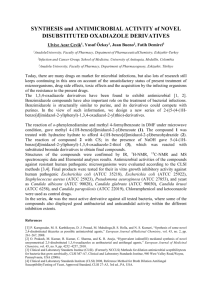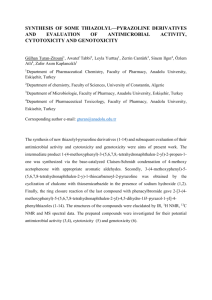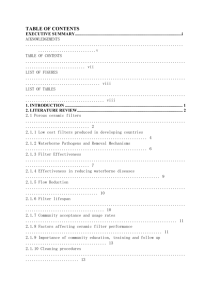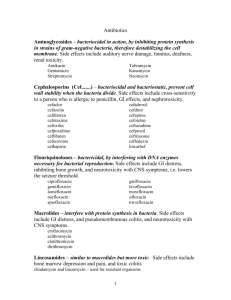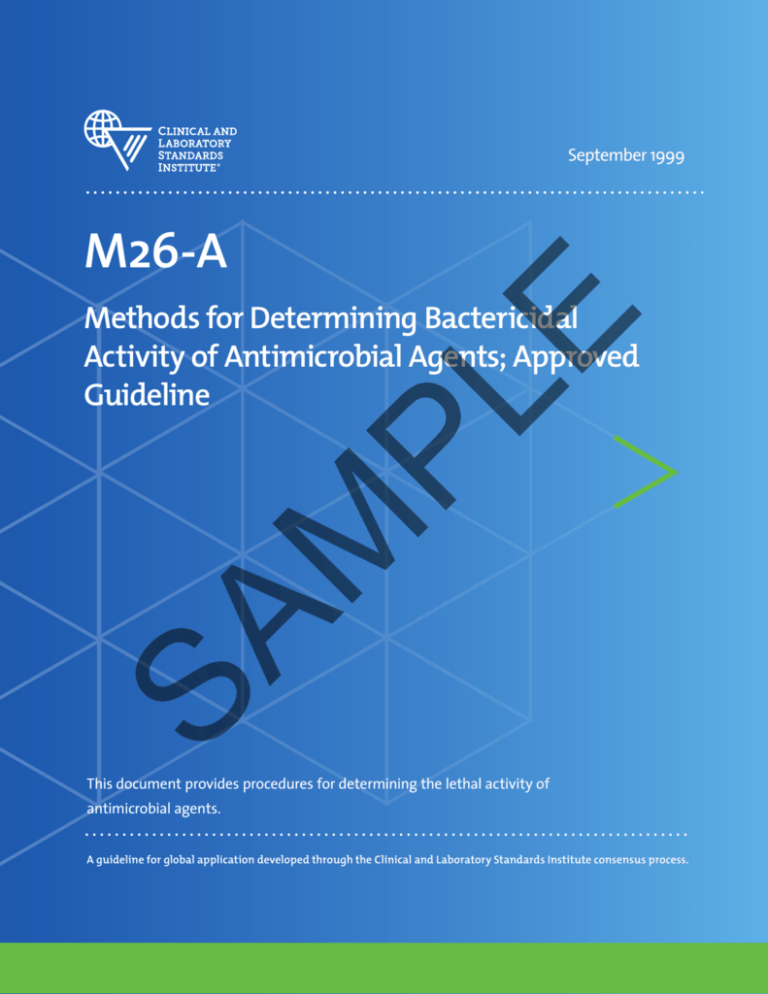
September 1999
M26-A
SA
M
PL
E
Methods for Determining Bactericidal
Activity of Antimicrobial Agents; Approved
Guideline
This document provides procedures for determining the lethal activity of
antimicrobial agents.
A guideline for global application developed through the Clinical and Laboratory Standards Institute consensus process.
Clinical and Laboratory Standards Institute
Setting the standard for quality in clinical laboratory testing around the world.
The Clinical and Laboratory Standards Institute (CLSI) is a not-for-profit membership organization that brings
together the varied perspectives and expertise of the worldwide laboratory community for the advancement of
a common cause: to foster excellence in laboratory medicine by developing and implementing clinical laboratory
standards and guidelines that help laboratories fulfill their responsibilities with efficiency, effectiveness, and
global applicability.
Consensus Process
E
Consensus—the substantial agreement by materially affected, competent, and interested parties—is core to the
development of all CLSI documents. It does not always connote unanimous agreement, but does mean that the
participants in the development of a consensus document have considered and resolved all relevant objections
and accept the resulting agreement.
Commenting on Documents
PL
CLSI documents undergo periodic evaluation and modification to keep pace with advancements in technologies,
procedures, methods, and protocols affecting the laboratory or health care.
CLSI’s consensus process depends on experts who volunteer to serve as contributing authors and/or as
participants in the reviewing and commenting process. At the end of each comment period, the committee that
developed the document is obligated to review all comments, respond in writing to all substantive comments,
and revise the draft document as appropriate.
Appeals Process
M
Comments on published CLSI documents are equally essential, and may be submitted by anyone, at any time, on
any document. All comments are addressed according to the consensus process by a committee of experts.
SA
If it is believed that an objection has not been adequately addressed, the process for appeals is documented in
the CLSI Standards Development Policies and Process document.
All comments and responses submitted on draft and published documents are retained on file at CLSI and are
available upon request.
Get Involved—Volunteer!
Do you use CLSI documents in your workplace? Do you see room for improvement? Would you like to get
involved in the revision process? Or maybe you see a need to develop a new document for an emerging
technology? CLSI wants to hear from you. We are always looking for volunteers. By donating your time and
talents to improve the standards that affect your own work, you will play an active role in improving public
health across the globe.
For further information on committee participation or to submit comments, contact CLSI.
Clinical and Laboratory Standards Institute
950 West Valley Road, Suite 2500
Wayne, PA 19087 USA
P: 610.688.0100
F: 610.688.0700
www.clsi.org
standard@clsi.org
Vol. 19 No. 18
NOTE: This document is no longer being reviewed as part of the CLSI consensus process. However, because of its usefulness to segments of the health care community, it is available for its informational content. M26-A
Methods for Determining Bactericidal Activity of Antimicrobial
Agents; Approved Guideline
Abstract
E
PL
Established laboratory methods that can assess the bactericidal activity of an antimicrobial agent are
needed, both because of the increase in the number of patients who do not have completely normal
host immune defenses and because of the new classes of antimicrobial agents that have been
introduced. Clinical cure depends largely upon host factors. Bactericidal tests can provide a rough
prediction of bacterial eradication. It should be noted, however, that other factors (e.g., postantibiotic
effect and the growth-inhibitory effects of sub-MIC concentrations of antibiotics) may also impact
bacteriologic response of patients. The special susceptibility tests that assess lethal activity are not
routinely applied to all microorganisms, but are applied in unusual situations; e.g., endocarditis. Uniform
test procedures are thus needed to permit comparison of different datasets.
M
The methods for bactericidal testing are now evolving, but more work is needed with the methodological
aspects and clinical correlations. The techniques described in this document are intended primarily for
testing aerobic bacteria that grow after incubation in adjusted Mueller-Hinton broth or adjusted MuellerHinton broth supplemented with human serum or an ultrafiltrate thereof.
Clinical and Laboratory Standards Institute (CLSI). Methods for Determining Bactericidal Activity of
Antimicrobial Agents; Approved Guideline. CLSI document M26-A ( ISBN 1-56238-384-1). Clinical and
Laboratory Standards Institute, 950 West Valley Road, Suite 2500, Wayne, Pennsylvania 19087.
SA
The Clinical and Laboratory Standards Institute consensus process, which is the mechanism for moving a
document through two or more levels of review by the health care community, is an ongoing process. Users should
expect revised editions of any given document. Because rapid changes in technology may affect the procedures,
methods, and protocols in a standard or guideline, users should replace outdated editions with the current editions
of CLSI documents. Current editions are listed in the CLSI catalog and posted on our website at www.clsi.org. If
your organization is not a member and would like to become one, and to request a copy of the catalog, contact us
at: Telephone: 610.688.0100; Fax: 610.688.0700; E-Mail: customerservice@clsi.org; Website: www.clsi.org.
i
M26-A
ISBN 1-56238-384-1
ISSN 0273-3099
September 1999
Methods for Determining Bactericidal Activity of Antimicrobial
Agents; Approved Guideline
E
Volume 19 Number 18
SA
M
Arthur L. Barry, Ph.D.
William A. Craig, M.D.
Harriette Nadler, Ph.D.
L. Barth Reller, M.D.
Christine C. Sanders, Ph.D.
Jana M. Swenson, M.M.Sc.
PL
September 1999
NCCLS
Copyright ©1999 Clinical and Laboratory Standards Institute. Except as stated below, any reproduction of
content from a CLSI copyrighted standard, guideline, companion product, or other material requires
express written consent from CLSI. All rights reserved. Interested parties may send permission requests to
permissions@clsi.org.
E
CLSI hereby grants permission to each individual member or purchaser to make a single reproduction of
this publication for use in its laboratory procedure manual at a single site. To request permission to use this
publication in any other manner, e-mail permissions@clsi.org.
Suggested Citation
Proposed Guideline
September 1986
Tentative Guideline
September 1992
September 1999
SA
M
Approved Guideline
PL
CLSI. Methods for Determining Bactericidal Activity of Antimicrobial Agents; Approved Guideline.
CLSI document M26-A. Wayne, PA: Clinical and Laboratory Standards Institute; 1999.
ISBN 1-56238-384-1
ISSN 0273-3099
iv
Vol. 19 No. 18
M26-A
Contents
Abstract.............................................................................................................................. i
Committee Membership ........................................................................................................ v
Active Membership ............................................................................................................. vii
Foreword...........................................................................................................................xv
Introduction ........................................................................................................... 1
Test Methods for Determining Bactericidal Activity ...................................................... 8
2.1
2.2
2.3
2.4
2.5
3
Preparation of Antimicrobial Solutions ............................................................. 8
Broth Medium.............................................................................................. 8
Time-Kill Method .......................................................................................... 9
Dilution Methods........................................................................................ 10
Preparing Inoculum ..................................................................................... 12
PL
2
Rationale .................................................................................................... 1
Methods ..................................................................................................... 1
Problems..................................................................................................... 1
Clinical Relevance ........................................................................................ 6
E
1.1
1.2
1.3
1.4
Determining Endpoints........................................................................................... 13
3.1
3.2
3.3
Time-Kill Method ........................................................................................ 13
Agar Dilution Plate Count Method................................................................. 14
Minimal Bactericidal Concentrations .............................................................. 14
M
1
4
Interpretation ....................................................................................................... 15
5
Quality Control ..................................................................................................... 16
Purpose ....................................................................................................
Method Control..........................................................................................
Selecting Reference Strains .........................................................................
Suggested Quality Control Strains ................................................................
Batch or Lot Control ...................................................................................
Other Control Procedures ............................................................................
SA
5.1
5.2
5.3
5.4
5.5
5.6
16
16
16
16
16
16
Table 1. Rejection Value and Calculated Sensitivity and
Specificity for Each Initial Concentration on the Basis
of Duplicate 0.01-mL Samples ................................................................................ 17
Table 2. Rejection Value and Calculated Sensitivity and
Specificity for Each Initial Inoculum Concentration on the
Basis of a Single 0.01-mL Sample ........................................................................... 18
Table 3. Suitable Quality Control Ranges for MICs and
MBCs With and Without Human Serum Using ATCC Strains ....................................... 19
xiii
September 1999
NCCLS
Contents (Continued)
References ....................................................................................................................... 20
Additional References......................................................................................................... 26
Summary of Comments and Subcommittee Responses ........................................................... 27
SA
M
PL
E
Related NCCLS Publications ................................................................................................ 29
xiv
Vol. 19 No. 18
M26-A
Foreword
All of the susceptibility test methods commonly performed by clinical microbiology laboratories (e.g.,
disk diffusion, broth dilution, and agar dilution) measure the inhibitory activity (MIC) of an antimicrobial
agent.1,2,3 In most clinical situations, this is sufficient as the role of the antibiotic is to prevent the
spread of bacteria from the focus of infection by preventing microbial replication at new sites; the active
participation of the host's defense mechanisms finally achieves bacterial eradication and clinical cure.4
Antimicrobial assays can provide additional valuable information on the pharmacokinetics of the
agent(s) being used and, when combined with the MICs, can allow bacterial eradication to be predicted.
E
On occasion, it may be necessary to achieve bactericidal activity with an antimicrobial agent. This need
has been well documented for endocarditis5 and has been suggested by some for meningitis,6 for
osteomyelitis,7 as well as for infections in immunocompromised patients.8 The clinical occurrence of
tolerance9 may on rare occasion necessitate bactericidal testing.
PL
When assessment of bactericidal activity is deemed appropriate, an in vitro test method such as the
MBC determination or the use of time-kill kinetic methodology may be useful. Bactericidal activity
against the patient's isolate by the antibiotic tested allows eradication to be predicted based upon the
usual dosing of this antibiotic or based upon the results of an antimicrobial assay. When clinical
experience is lacking and assay methods are not readily available, the serum bactericidal test which
integrates both pharmacodynamic and pharmacokinetic properties may be more useful. Depending on
certain modifications to the serum bactericidal test, the test can provide a quantitative assessment of
bactericidal activity relative to the MBC (the serum bactericidal titer), a dynamic assessment of rapidity
of killing over time (the serum bactericidal rate), or both the magnitude of serum bactericidal activity and
its duration (the area-under-the-bactericidal-titer-curve). In addition, methods using serum from persons
(e.g., volunteers) receiving antibiotics (ex vivo) can be used to assess antimicrobial bactericidal activity
across drug classes or between members of a class against a wide variety of microorganisms.
SA
M
Because of the complexity involved with the serum bactericidal test (including the particular method
used, the proper collection of timed serum specimens, and the interpretation of results), and the lack
of clinical data clearly documenting the usefulness of this test for most infections, it is recommended
that consultation with the microbiology laboratory be obtained as a prerequisite for this test. The
assistance of the laboratory's director is useful in (1) determining if such a test is needed; (2) selecting
NCCLS recommended methodology for testing; and (3) interpreting the results. Techniques for the
conduct of the serum bactericidal test may be found in the most current edition of NCCLS document
M21—Methodology for the Serum Bactericidal Test.
This document describes the details of bactericidal testing and, in particular, the effects of variations
in methodology. This information has been obtained largely from published data. Use of these guidelines
should result in uniform methodology for bactericidal testing that is sufficiently practical for use in the
clinical microbiology laboratory. The methodology described in this document does not imply per se that
bactericidal testing is clinically relevant, but instead allows such testing to be used as a tool to assess
clinical relevance. The techniques described in this document are intended primarily for testing aerobic
bacteria that grow well after overnight incubation in either Mueller-Hinton broth or in Mueller-Hinton
broth supplemented with human serum as described in Section 2.2.1. Modifications for more fastidious
microorganisms such as anaerobes will be described in detail in the future.
xv
September 1999
NCCLS
Standard Precautions
E
Because it is often impossible to know what might be infectious, all human blood specimens are to be
treated as infectious and handled according to “standard precautions.” Standard precautions are new
guidelines that combine the major features of “universal precautions and body substance isolation”
practices. Standard precautions cover the transmission of any pathogen and thus are more
comprehensive than universal precautions which are intended to apply only to transmission of bloodborne pathogens. Standard precaution and universal precaution guidelines are available from the U.S.
Centers for Disease Control and Prevention (Guideline for Isolation Precautions in Hospitals, Infection
Control and Hospital Epidemiology, CDC, Vol 17;1:53-80.), [MMWR 1987;36(suppl 2S):2S-18S] and
(MMWR 1988;37:377-382, 387-388). For specific precautions for preventing the laboratory
transmission of blood-borne infection from laboratory instruments and materials; and recommendations
for the management of blood-borne exposure, refer to NCCLS document M29—Protection of Laboratory
Workers from Instrument Biohazards and Infectious Disease Transmitted by Blood, Body Fluids, and
Tissue.
Key Words
SA
M
PL
Bactericidal activity, minimal bactericidal concentration (MBC), minimal lethal concentration, serum
bactericidal concentration, time-kill determination
xvi
Vol. 19 No. 18
M26-A
Methods for Determining Bactericidal Activity
of Antimicrobial Agents; Approved Guideline
MIC.10,11,12 This rate of killing is termed
time-dependent bactericidal activity.
1 Introduction
1.2 Methods
M
PL
An increasing number of patients with
infections do not have completely normal host
immune defenses. In addition, classes of
antibiotics that have been considered to be
bactericidal can no longer be assumed to kill
every clinical isolate due to the possibility of
tolerance.9 Finally, as new classes of
antimicrobial agents are introduced, there is a
need for established laboratory methods that
can assess the bactericidal activity of these
agents. Such methods for assessing lethal
activity
should
be
considered
special
susceptibility tests because they are not
routinely applied to all microorganisms; rather,
they are applied in unusual situations. Because
of their specialized nature, complexity, and
potential difficulty for interpretation, tests for
bactericidal activity should be done in the
context of consultation with appropriate
persons (such as the microbiology laboratory
director) who are aware of the potential
problems involved in such testing.
(2) The minimal concentration of drug needed
to kill most ($99.9%) of the viable
organisms after incubation for a fixed length
of time (generally 24 hours) under a given
set of conditions is the most common
estimation of bactericidal activity and is
known as either the minimal bactericidal
concentration (MBC) or the minimal lethal
concentration (MLC). It will be referred to in
this document as the MBC. Unfortunately,
the definition of the MBC (99.9% killing of
the final inoculum) is somewhat arbitrary
and separates the bacteria into two
populations – a segrega-tion which might
not have biological relevance.13 The
determination of the MBC, moreover, is so
subject to methodologic variables that the
clinical relevance of MBCs is nearly
impossible to assess, particularly for certain
pathogen and drug combinations (e.g.,
staphylococci and beta-lactam agents).14
E
1.1 Rationale
SA
The killing effect of an antimicrobial agent on a
microorganism can be assessed in several
ways:
(1) Lethal activity may be expressed as the rate
of killing by a fixed concentration of drug
under controlled conditions. This rate is
determined by measuring the number of
viable bacteria at various time intervals. The
resulting graphic depiction is known as the
time-kill curve. Bacterial killing rates are, in
part, dependent on the class of antibiotic
and the concentration of this agent. With
certain classes of antibiotics (e.g.,
aminoglycosides and fluoroquino-lones), the
rate of killing increases with increased drug
concentrations up to a point of maximum
effect.10
This
is
termed
concentration-dependent bactericidal activity. In contrast, the killing rates of $-lactam
agents and vancomycin are relatively slow
and continue only as long as the
concentrations are in excess of the
(3) The serum of a patient receiving an
antibiotic may be tested against the
infecting microorganism. This can be done
using time-kill curve methodology (i.e.,
serum bactericidal rate) or using dilution
methodology (i.e., serum bactericidal titer).
The principles of these methods as well as
the influence of biological and technical
factors are similar.
1.3 Problems
Evaluating in vitro lethal effects of an
antimicrobial agent is conceptually attractive
and appears, at times, to be clinically
necessary. However, many biological and
technical factors are known to interfere with
such in vitro measurement of killing.
The biological factors include:
•
Persisters
•
Paradoxical effect
•
Tolerance
1
September 1999
been found to lyse RNA20 and this might be
related to the paradoxical effect.
Phenotypic resistance.
The technical factors include:
•
Growth phase of inoculum
•
Inoculum size
•
Insufficient contact
•
Volume transferred
•
Antibiotic carryover
•
Choice of media.
There is also another mechanism of
penicillin-induced cell death which is not related
to lysis21; the relationship of this mechanism to
the paradoxical effect is unknown. A
paradoxical effect of aminoglycosides on the
growth of gram-negative bacilli also has been
described.22
1.3.1
1.3.1.1
Biological Factors
Persisters
PL
These variables create uncertainty in the
interpretation of bactericidal activity and are a
major reason that professional consultation with
the microbiology director is needed.
SA
M
For some well-studied antibiotics, e.g., $-lactam
agents, a small number (usually <0.1% of the
final inoculum) of bacteria were found to
survive the lethal effect of an antibiotic.15 If
these persisters are retested, they are just as
susceptible as the parent strain and no greater
proportion of cells persist. This phenomenon is
thought to be due to the fact that some cells
are dormant or replicating slowly and
consequently are not killed by the antimicrobial
agent.16
The rate of antimicrobial agentinduced killing is strictly proportional to the rate
of bacterial growth.17 Thus, the slower the rate
of bacterial growth, the slower the bactericidal
effect of the antibiotic. As the growth of a
microorganism reaches its maximum, the rate
slows and so does the killing effect.
1.3.1.2
Paradoxical Effect
Another factor known as the paradoxical effect
occurs when the proportion of surviving cells
increases significantly as the concentration of
the antimicrobial agent increases beyond the
MBC.18,19 This phenomenon is particularly
common for cell wall-active agents. It is
thought that a high concentration of penicillin
inhibits protein synthesis to a degree which
prevents the growth necessary for expression of
the lethal effect of the drug. Penicillin also has
2
The clinical relevance of the paradoxical effect
is unclear. However, Eagle and his coworkers23
infected mice with group B streptococci and
demonstrated that the bacteria were killed in
vivo more slowly by high doses of penicillin.
There is at least one reported case24 where a
reduction in dosage of penicillin (peak levels
decreasing from 36.7 to 11.3 :g/mL) resulted
in a marked increase in bactericidal activity in
the patient's serum (peak titers increasing from
1:8 to 1:256) with coincident improvement in
clinical status.
E
•
NCCLS
1.3.1.3
Tolerance
Tolerance means that the microorganism is able
to evade only the lethal action of the
antimicrobial agent; there is no change in the
MIC.9,18,25-27 At least four mechanisms have
been described which enable clinical isolates to
survive during therapy with cell-wall-active
agents. Two of these, persisters and the
paradoxic effect, have already been described.
Another mechanism is phenotypic tolerance.16
Phenotypic tolerance is a property of virtually all
strains of bacteria and is defined as decreased
susceptibility to antimicrobial agents which is
manifested only under certain growth
conditions.
The last mechanism of tolerance is that in
which a microorganism possesses or acquires a
unique genetic property, such as a defective
autolytic system.27
All tolerant isolates, no matter which
mechanism is responsible, exhibit unusually
high MBCs relative to their MICs, and tolerance
has been defined as an MBC-MIC ratio of 1:32
or greater after 24 hours of incubation.
However, such a ratio cannot distinguish
phenotypic tolerance from tolerance due to a
unique genetic property. Instead, a time-kill
kinetic study is needed to differentiate these
Vol. 19 No. 18
M26-A
Related NCCLS Publications*
Performance Standards for Antimicrobial Disk Susceptibility Test—Sixth Edition;
Approved Standard (1997). This document provides current recommended techniques
for disk susceptibility testing, new frequency criteria for quality control testing, and
updated tables for interpretive zone diameters.
M7-A4
Methods for Dilution Antimicrobial Susceptibility Tests for Bacteria That Grow
Aerobically—Fourth Edition; Approved Standard (1997). This document provides
reference methods for the determination of minimal inhibitory concentrations (MIC) of
aerobic bacteria by broth macrodilution, broth microdilution, and agar dilution.
M11-A4
Methods for Antimicrobial Susceptibility Testing of Anaerobic Bacteria; Approved
Standard—Fourth Edition (1997). This document provides methods for susceptibility
testing of anaerobic bacteria; description of reference agar dilution method, alternative
agar methods (Wadsworth and limited dilutions), broth microdilution, and broth (macro)
dilution procedures, and quality control criteria for each procedure.
M21-A
Methodology for the Serum Bactericidal Test; Approved Guideline (1999). This document
provides a direct method of antimicrobial susceptibility testing using a patient's serum
to measure the activity of the serum against the bacterial pathogen isolated from the
patient.
M29-A
Protection of Laboratory Workers from Instrument Biohazards and Infectious Disease
Transmitted by Blood, Body Fluids, and Tissue; Approved Guideline (1997). This
document provides guidance on the risk of transmission of hepatitis viruses and human
immunodeficiency viruses in any laboratory setting; specific precautions for preventing
the laboratory transmission of blood-borne infection from laboratory instruments and
materials; and recommendations for the management of blood-borne exposure.
SA
M
PL
E
M2-A6
NOTES
* Proposed- and tentative-level documents are being advanced through the NCCLS consensus process; therefore, readers should
refer to the most recent editions.
29
PL
As we continue to set the global standard
for quality in laboratory testing, we’re
adding initiatives to bring even more
value to our members and customers.
E
Explore the Latest
Offerings from CLSI!
Shop Our Online
Products
Including eM100, the interactive
searchable database for drug
selection, interpretation, and
quality control procedures within
M100-S23.
The value of a CLSI membership begins with significant discounts—
up to 70% off—on our trusted clinical laboratory standards and
guidelines, but the benefits extend far beyond cost savings:
Benefits to Industry
Contribute to Standards that Streamline Product Review Processes
Access a Deep Network of Customers, Peers, Regulators, and Industry Leaders
Raise Your Organization’s Profile in the Clinical Laboratory Community
Benefits to Laboratories
Directly Influence CLSI Standards to Ensure they are Practical and Achievable
Access Globally Recognized Standards for Accreditation Preparedness
Help Drive Higher Levels of Patient Care Quality All Over the World
Benefits to Government
Aid in the Development of Consensus Standards that can Impact Legislation
Connect with Over 2,000 Influential Organizations Across the Global Laboratory Community
Help Laboratories Provide Safe and Effective Care of the Highest Quality and Value
www.clsi.org/membership
About CLSI
M
The Clinical and Laboratory Standards Institute
Visit the CLSI U
Education Center
SA
Where we provide the convenient
and cost-effective education
resources that laboratories
need to put CLSI standards into
practice, including webinars,
workshops, and more.
Shop Our Online
Products
e CLIPSE
TM
Ultimate Access
Including eCLIPSE Ultimate
Access™, CLSI’s cloud-based,
online portal that makes it easy
to access our standards and
guidelines—anytime, anywhere.
Introducing CLSI’s
New Membership
Opportunities
(CLSI) is a not-for-profit membership organization
that brings together the varied perspectives and
expertise of the worldwide laboratory community
for the advancement of a common cause: to foster
excellence in laboratory medicine by developing
and implementing clinical standards and guidelines
950 West Valley Road, Suite 2500, Wayne, PA 19087
P: 610.688.0100 Toll Free (US): 877.447.1888
F: 610.688.0700 E: membership@clsi.org
that help laboratories fulfill their responsibilities
with efficiency, effectiveness, and global applicability.
More Options. More Benefits. More Value.
Join in Our Mission to Improve
Health Care Outcomes
We’ve made it even easier for your organization to take
full advantage of the standards resources and networking
opportunities available through membership with CLSI.
Find Membership
Opportunities
See the options that make it even
easier for your organization to take
full advantage of CLSI benefits and
our unique membership value.
For more information, visit
www.clsi.org today.
E
PL
M
SA
950 West Valley Road, Suite 2500, Wayne, PA 19087 USA
P: 610.688.0100 Toll Free (US): 877.447.1888 F: 610.688.0700
E: customerservice@clsi.org www.clsi.org
ISBN 1-56238-384-1


